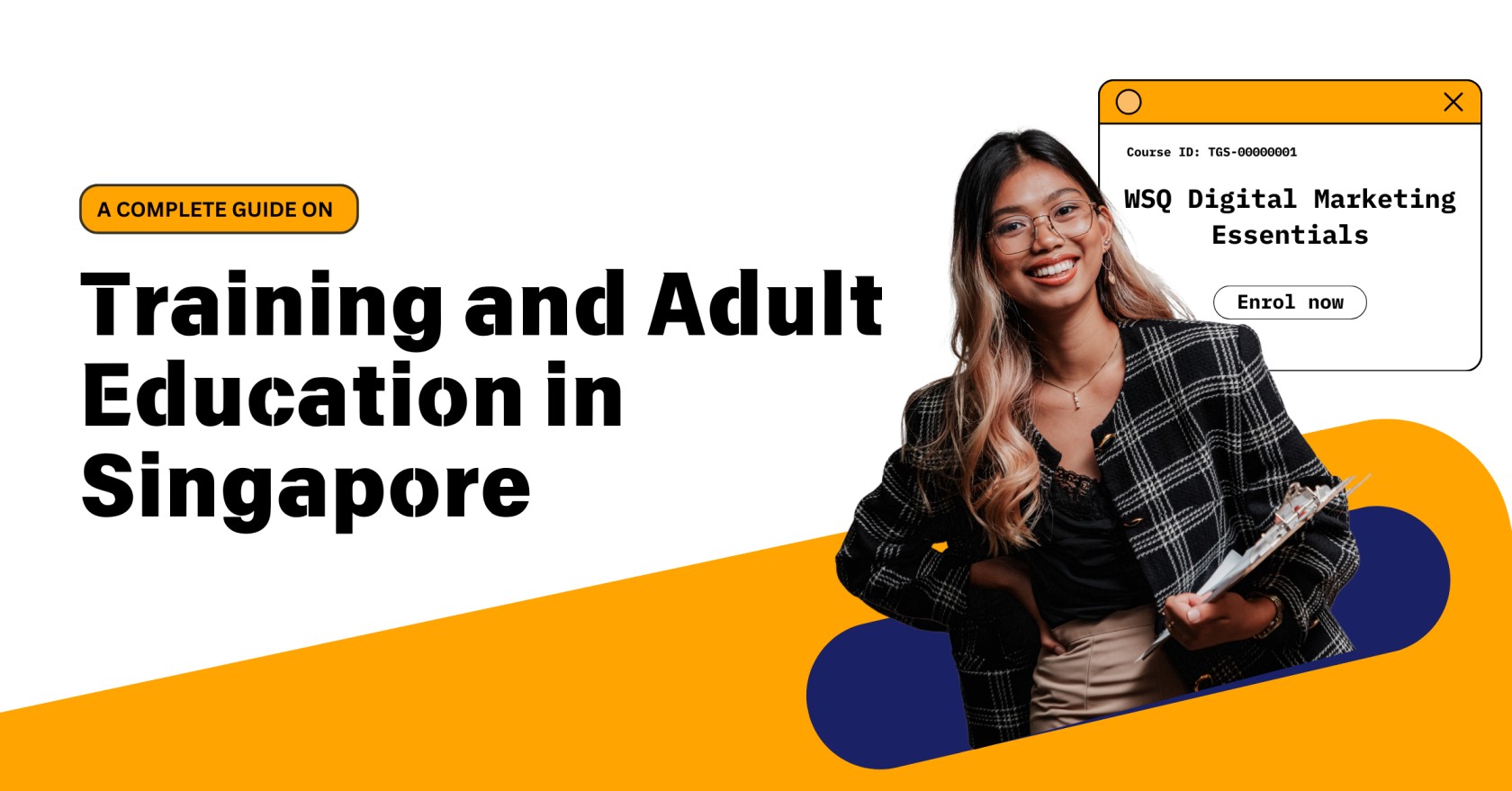- HOME
- E-Learning trends
- Navigating Singapore's Training and Adult Education sector with online training platforms
Navigating Singapore's Training and Adult Education sector with online training platforms
- Last Updated : February 14, 2025
- 609 Views
- 10 Min Read

The "little red dot," as Singapore is often nicknamed, is a small nation with a population of around 5.6 million and little to no natural resources. Despite this, its influence in sectors like finance, manufacturing, education, and public welfare is huge.
To remain competitive on the global stage, Singapore leverages its most valuable asset—its people. The country invests heavily in education and adult learning to build a skilled, adaptable, and future-proof workforce.
In this blog post, we’ll take a closer look at the Training and Adult Education (TAE) industry in Singapore, the key roles within it, the professionals in the field, the challenges they face, the government initiatives that support them, and how online course platforms like TrainerCentral can help TAE professionals thrive through blended learning and a full transition to online training.
The Training and Adult Education industry in Singapore
The TAE sector in Singapore focuses on delivering continuous learning opportunities for everyone to develop new skills, enhance their expertise, and boost their employability.
The sector plays a key role in nurturing a culture of lifelong learning and supporting Singapore’s economic growth by ensuring that their workforce remains competitive and future-ready.
Key roles in the TAE sector
Here are a few crucial roles that the TAE sector in Singapore aims to address.
Upskilling and reskilling the workforce
The TAE sector helps working adults acquire new skills or upgrade their existing ones to adapt to changes in the job market.
Continuous learning
This sector helps promote continuous education through flexible and structured programs, allowing adults and working professionals to learn while managing their other responsibilities—both professional and personal.
Industry-relevant training
The sector offers courses customized to specific industries, ensuring that workers have the expertise required to meet the growing industry demands.
Supporting national initiatives
The TAE sector plays a central role in implementing initiatives like SkillsFuture and iNLEARN 2.0, which provides financial and structural support for learning programs.
More than just job skills
Continuous learning not only improves job opportunities and provides better wages, but also brings personal and social benefits. Studies show that learning can enhance mental well-being, improve behaviour, and even lead to better health.
For example:
Training can improve communication and social skills, which help build strong relationships.
Lifelong learning can empower people to handle any challenges in their lives.
Education has even been linked to reducing health issues and crime rates.
Who are TAE providers?
Based on the study, Training and Adult Education landscape in Singapore: characteristics, challenges, and policies, TAE providers are organizations or institutions that primarily focus on delivering continuing education for adults.
They help adults get trained in the skills and knowledge they need to stay up to date and competitive in the workforce.
TAE providers specifically focus on Training and Adult Education (TAE) services, emphasizing adult learning, whereas TPs (training providers) is a more general term that can refer to any training organization.
Based on the study, there are seven types of TAE providers:
1. Government-approved training providers
These are officially recognized by government agencies and often follow strict guidelines to provide certified training programs.
Example: Singapore Workforce Development Agency (WDA)
2. Private education institutes
Privately owned organizations offering a variety of adult education courses, often targeting specific industries like IT, finance, or healthcare.
Example: PSB Academy
3. Post-secondary education institutes
These include polytechnics and universities that extend their offerings to working professionals through diploma or certificate courses.
Example: Ngee Ann Polytechnic
4. Public sector training institutions
Organizations run by the government to train civil servants and public sector employees.
Example: Civil Service College Singapore (CSC)
5. Private training organizations
Independent companies that design and deliver training programs for adults, often focusing on niche areas or skill sets.
Example: Kaplan Learning Institute
6. Training arms of associations and professional bodies
Professional associations (e.g., for engineers, accountants) that offer courses to help their members stay updated in their fields.
Example: ICC Academy
7. In-house training providers
Companies that run internal training programs to upskill their employees, focusing on their specific organizational needs.
Example: Organizations with internal training programs to upskill their workforce.
However, the sector is fragmented and highly dynamic, with many providers relying on freelance trainers instead of full-time staff.
Who are TAE professionals?
TAE professionals in Singapore are the individuals behind adult education programs. They have specific roles to design, deliver, and manage training. The study focuses on three main groups:
1. Adult Educators (AEs)
These professionals are the frontline trainers. Their responsibilities include:
- Analysis: Understanding what the learners or organizations need.
- Design: Creating effective training materials, courses, or workshops tailored to these needs.
- Facilitation: Conducting sessions or workshops to deliver the training.
- Assessment: Evaluating the performance and learning outcomes of participants.
Example: An AE conducts a workshop on digital marketing for professionals transitioning into tech roles, providing hands-on exercises and follow-up assessments.
2. Training Managers (TMs)
These individuals ensure the smooth operation of training institutions. Their tasks are broader and focus on managing the training organization. This includes:
- Overseeing the development and implementation of training programs.
- Managing administrative tasks like budgets, staff schedules, and resources.
- Ensuring compliance with government regulations and maintaining quality assurance.
- Monitoring learning systems and feedback to improve programs.
Example: A TM oversees the rollout of a new leadership course at a corporate training center, ensuring everything—from content to logistics—is aligned.
3. Human Resource Developers (HRDs)
These professionals work at a strategic level to influence policy and practice in training. Their responsibilities include:
- Researching workforce needs to develop new competency frameworks.
- Auditing course quality to ensure it meets industry and educational standards.
- Creating employment facilitation programs to connect trained individuals with job opportunities.
Example: An HRD creates a framework to assess soft skills, like teamwork or leadership, and integrate it into company's internal training programs.
Types of courses offered by training providers in Singapore
Most training providers offer a mix of programs, with some specializing in workforce skills qualifications (WSQ) programs and others offering non-WSQ options. Many providers diversify their services to include consultancy, which is expected to grow due to organizations' demand for customized training solutions.
How much do training providers in Singapore make?
Based on the study:
Many TPs operate in the lower revenue range: A significant portion of TPs generate relatively lower revenue.
Some TPs generate substantial revenue: A smaller portion of TPs earn significantly higher revenue, ranging from hundreds of thousands to tens of millions of dollars.
A very small percentage of TPs generate extremely high revenue: Only a tiny fraction of TPs operate at the highest revenue levels, earning tens of millions of dollars or more.
In essence, the revenue earned by TPs ranges from relatively low to very high, with the majority falling in the lower to mid-range categories.
Government initiatives supporting the TAE industry
Singapore launched the SkillsFuture initiative as a national program to ensure that their workforce is well-prepared for the future economy. It emphasizes the need for continuous skills upgrading, which is crucial for maintaining a highly skilled, competitive workforce. Some of these government initiatives also provide grants to the training providers, which we'll cover in a separate blog post.
This is important because the nature of work is constantly evolving with technological advancements, global market changes, and shifts in business needs. Therefore, ongoing high-quality training and adult education are essential to help individuals remain competitive and future-ready in the labor market.
The key programs and policies under SkillsFuture are:
1. Capability Development Grants (CDG): Provides financial support to businesses for improving capabilities in areas like technology adoption, service standards, and employee training.
2. Enhanced training support for SMEs: Offers increased funding for SMEs that sponsor training for Singaporean employees, covering course fees and payroll during training.
3. English for the workplace program: Encourages companies to provide customized English training to help employees perform better and access better training opportunities.
4. iN.LEARN 2020: Promotes blended learning to enhance training quality and accessibility, helping providers and educators leverage technology for improved delivery.
5. SkillsFuture study award: Supports individuals who develop skills in high-demand sectors or areas critical for future economic growth.
6. SkillsFuture earn and learn program: A work-study program for polytechnic and ITE graduates to gain real-world experience and develop skills in their field of study.
7. SkillsFuture credit: Provides Singaporeans aged 25 and above with an opening credit of S$500 to fund approved courses, encouraging lifelong learning.
8. Training and Adult Education Professional Competency Model (TAEPCM): A framework that outlines competencies for adult educators, guiding their professional development.
9. Workforce Skills Qualifications (WSQ) System: A national system for certifying skills and competencies, ensuring that workforce qualifications meet industry standards.
10. Adult Education Network (AEN): A community for adult educators to collaborate, connect, and engage in professional development.
11. Adult Education Professionalisation (AEP): Aims to elevate the professional standards of adult educators, recognizing their pedagogical and professional excellence.
12. Singapore Accreditation Council (SAC): Provides conformity assessment services to ensure training programs and providers meet national standards.
These programs have enabled TPs and AEs to:
Improve the quality of their training offerings.
Attract more learners by aligning their courses with national economic priorities.
Enhance their own skills and expertise, making them more competitive in the market.
Expand their business and reach more customers, especially with the encouragement of blended learning and digital learning tools like LMS and online course platforms.
Challenges faced by TPs and AEs in Singapore
The study also talks about the challenges faced by both training providers and adult educators working in Singapore's Training and Adult Education sector. Here's a breakdown.
1. Business challenges
Training providers are facing tough competition in the market, and government regulations are also making things difficult. For example, some training providers are worried about the return on investment when adopting new technologies like tech-enabled learning and LMS.
They're concerned that such technologies may only be useful for a short period before they become outdated or irrelevant, which could be a risky investment.
2. Operational challenges
Many providers are struggling with how to use their resources effectively and how to deliver training products and services efficiently. In particular, training providers find it difficult to find qualified trainers.
3. Changes in the sector
There’s a shift in the TAE market, with entities like institutes of higher learning (IHLs) getting more involved in the sector. This creates both challenges and opportunities. The training providers are trying to adjust to the new trends, especially in terms of technology and changes in how learning is delivered.
4. Adapting to market changes
The TAE is evolving, especially with the rise of e-learning, mobile learning, and bite-sized courses. Educators need to keep up with these changes to stay relevant, but this can be challenging. For example, they need to learn new tools and platforms for delivering courses online, which requires time and effort.
5. Learner readiness
Some adult educators are frustrated because their learners aren't always prepared for the type of learning being offered. For instance, some learners may not be tech-savvy enough to handle online courses, and many do not complete their prerequisite online courses or modules before the in-person classes begin.
How online course platforms or LMS can solve these challenges
A few of the above challenges can be solved using LMS or online training platforms like TrainerCentral. We understand the worry surrounding the use of an LMS because the learning curve is steep for both the educators and learners, and the ROI for the money spent on the LMS.
Let's explain how this can be solved. Before we do that, there are a few reasons on why the TAE industry is reluctant to adopt an LMS or a training platform. These reasons include:
Current training methods are sufficient to meet learning goals.
The cost of implementing technology is too high.
Lack of expertise or financial resources to get started with new technologies.
Clients prefer traditional classroom-based training.
Limited resources to explore available learning technologies.
So the solution is to use a cloud-based training platform instead of an open-source one. Cloud-based online training platforms like TrainerCentral offer all the tools you need built in, rather than requiring you to build or integrate everything from scratch. Neither the training providers nor their learners need to be tech-savvy to use these platforms.
Let’s go over the advantages of using these platforms.
1. Everything is built-in
Open-source LMS platforms offer deep integrations; however, they require a huge amount of time, resources, and technical expertise to make everything work. But imagine a platform with all the tools you need—course builder, assessment maker, assignment evaluation, certificate builder, no-code website builder, live virtual classes, and many more—already built in, so you can focus on teaching instead of integrating other tech stacks.
2. Saves tons of money
Many may prefer a free open-source LMS or an online training platform. However, you’ll have to spend on hiring tech experts to implement and brand it your way.
Have you ever experienced two learning systems built with the same open-source platform, but one looks bad and the other looks better? The way your learning system looks and behaves entirely depends on the tech experts you hire.
On the other hand, platforms like TrainerCentral are affordable with a flat subscription rate, and with everything included, you need little to no tech help. You can use the saved amount for more useful things, like finding qualified trainers and training them.
3. Helps with blended learning
Without spending much on your learning platform, you can easily switch between face-to-face classes, self-paced online courses, and live virtual classes. You can conduct any type of class that both you and your learners are comfortable with.
4. Leverage government grants
Initiatives by the Singapore government like iNLEARN and SSG can help training providers and adult educators offset the costs of course platforms if they're used correctly. We'll write a separate blog post to explain this in detail.
Relevant read:Learn how Training Providers and Adult Educators in Singapore can leverage the SkillsFuture Singapore.
5. Ease of use
These online course platforms are easy to use and can be adopted by anyone. One does not need to be tech-savvy to use these platforms. Training providers can easily use these platforms to create their courses online, and learners find them easy to navigate.
Wrapping up
Though transitioning to an online training platform, whether to offer your courses completely online or for blended learning, may seem intimidating at first, platforms like TrainerCentral offer dedicated support to help you throughout the process and host your courses online.
The learning curve is so low that you can set up your online courses in less than 30 minutes. We’ll be writing more blog posts to help TAE professionals of Singapore increase productivity using an online training platform.
If you want a personalized demo of TrainerCentral, you can use this link to book one. Also, you can sign up for the product here. Leverage our platform and focus on teaching, instead of worrying about integrations and ROI.


